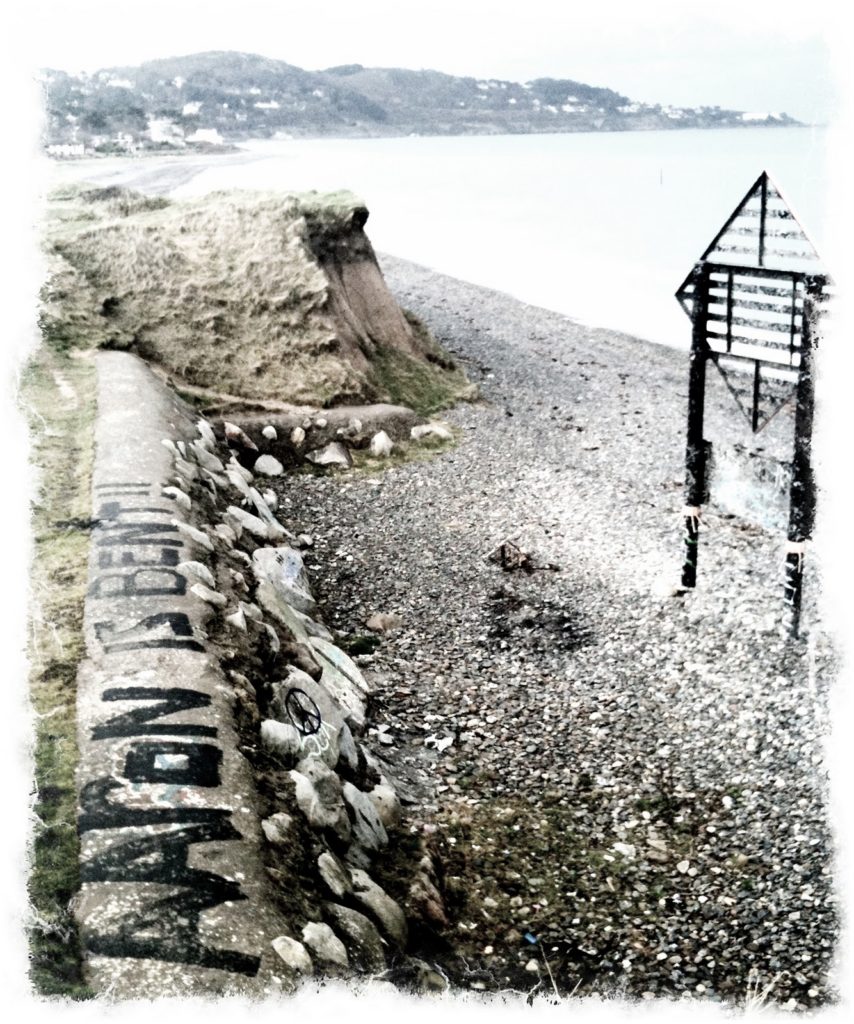‘It was drizzling most of the way, cold enough for gloves for the first hour and thereafter, wet, particularly so once I fell in the sea. After climbing across the granite/schist contact that separates White Rock and Killiney strands, I was walking in the shoals of wave washed glacial till that cover Killiney Beach. I chose the walk to have lots of different surfaces to help train my legs; steep steps, grass, heavy pebble beach and some climbing over huge boulders. Anyway, I needed to catch my breath and decided to take a picture at the water’s edge. The undertow sucked the pebbles from under my feet. I had the iPhone in photo mode. Over and in I went, the phone too. I grabbed the phone as a small wave broke over us and it still worked. My rain gear kept most of the water out though my pockets and shoes did fill up. It felt strange after spending an hour watching TV coverage of today’s tsunami in Japan.’

This is what I wrote on March 11th, 2011 after I went walking close to home in Dublin.
We didn’t yet know that the Fukushima Daiichi nuclear power facility was devastated by earthquake and the tsunami that followed. We wouldn’t know the horrors that faced the employees who would be tasked with handling the meltdown. We were focussed on other incomprehensible devastations. The immediate death toll, destruction of infrastructure and humanitarian concerns became ours too.
The tsunami reminded me that I was briefly involved with the Diablo Canyon nuclear power plant in California. I worked on a part of a geophysical study commissioned to look for unknown subsurface faults that might threaten the integrity of the facility.
Obviously, Fukushima gave Californians pause for thought. Coastal Fukushima is some 6 m above sea level and Diablo Canyon about 15 m above the water. The bigger issue is not the tsunami but the cause. Wikipedia says ‘Diablo Canyon was originally designed to withstand a 6.75 magnitude earthquake from four faults, including the nearby San Andreas and Hosgri faults, but was later upgraded to withstand a 7.5 magnitude quake. It has redundant seismic monitoring and a safety system designed to shut it down promptly in the event of significant ground motion.’
The plant was constructed in the late 60s and a dozen years later, geophysical technologies had evolved in leaps and bounds. So a project was designed to illuminate the subsurface with high density, digital geophysical tools. Unfortunately, as good as our technology had become, the project in 1981 was arguably a decade premature. We failed miserably because we applied two dimensional techniques that were unable to resolve a three dimensional problem.
Such plants must be considered as disasters waiting to happen and the problem gets worse with age. I don’t know what’s in place in Diablo Canyon today. I read that the seismic monitoring tools are running real time. They are designed to detect ground motion and trigger a facility shutdown if the ground motion exceeds critical thresholds. At best this will provide ‘just in time’ warnings. Warning sirens for the 500,000 people who live within 80 km won’t be required after the plant is finally shut down in 2025. And the decommissioning will take about ten years after some 55 years of service.
We are learning the lessons of Fukushima. ‘A 2016 NRC probabilistic risk assessment of the plant, taking into account seismic risk, estimated the frequency of core damage at one instance per 7.6 million reactor years.’
I haven’t read the report from NRC but I wonder about the relationship between motivated reasoning and unknown unknowns that could be assessed by way of a historical probabilistic risk assessment of Fukushima as might have been made in 2010.
I wonder if the 2020 movie Fukushima 50 is worth a look?

Leave a Reply